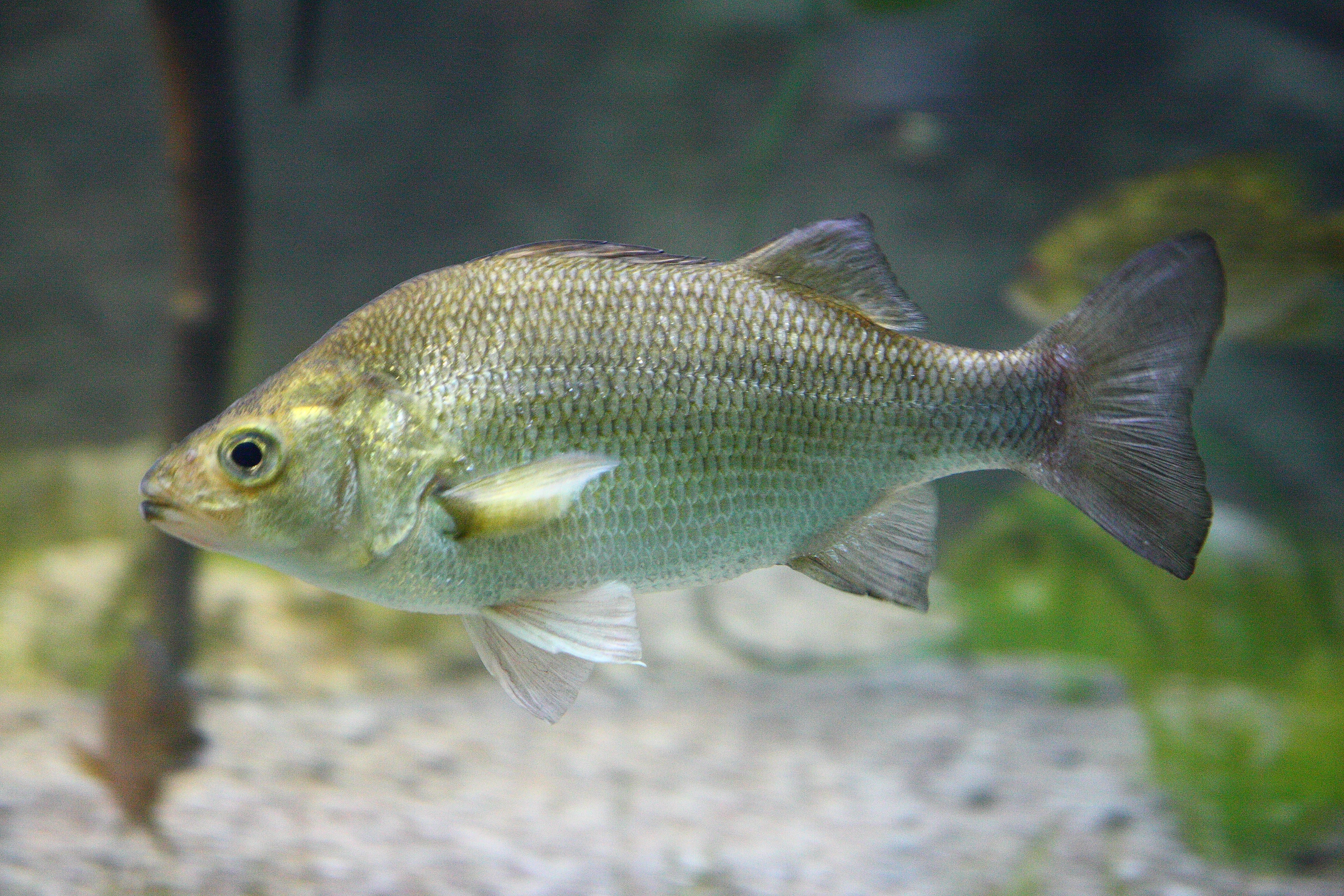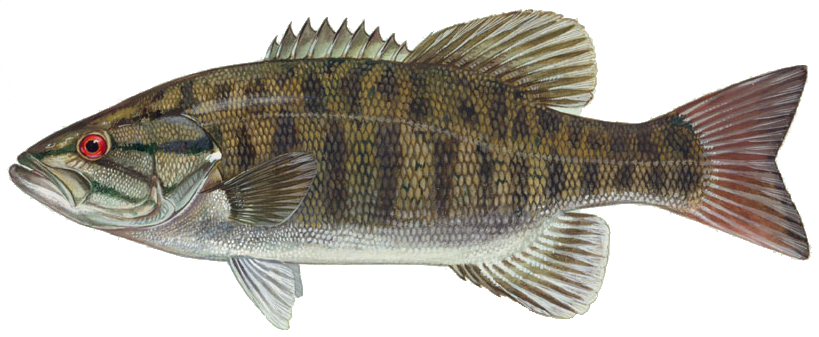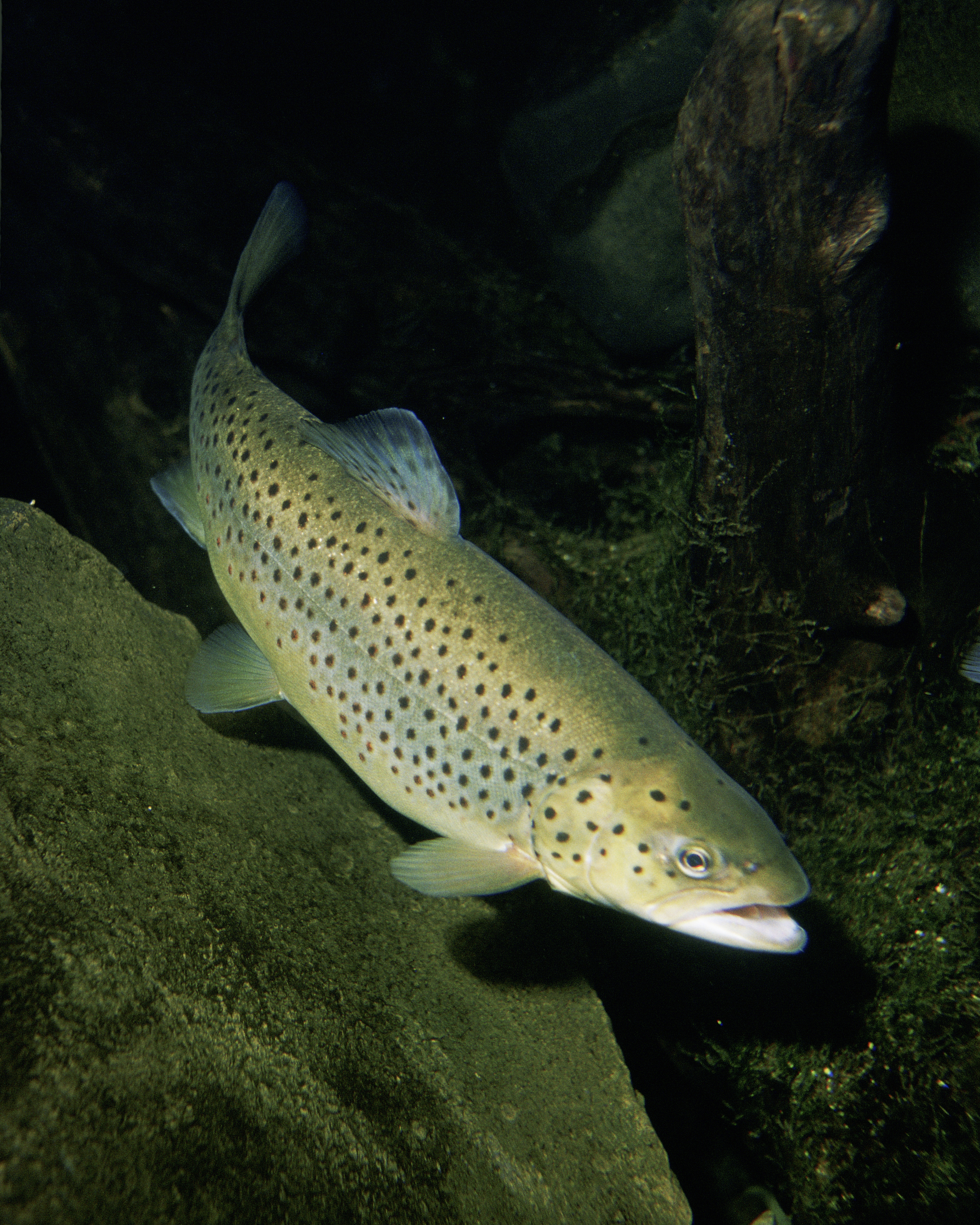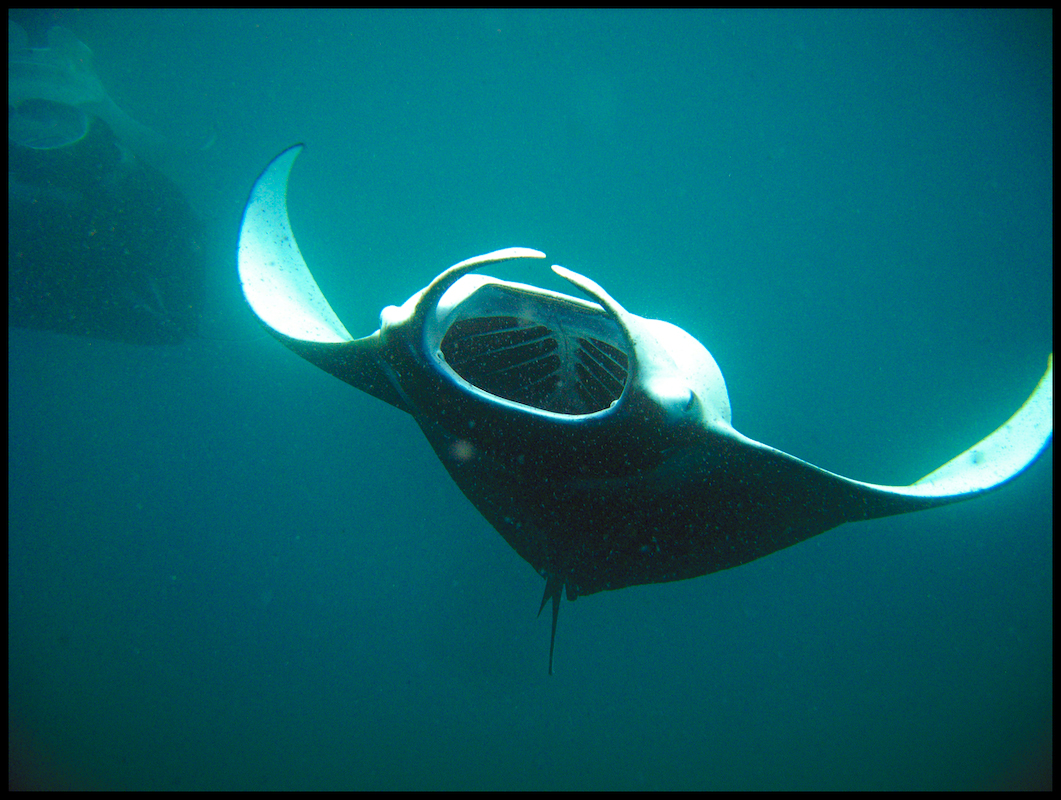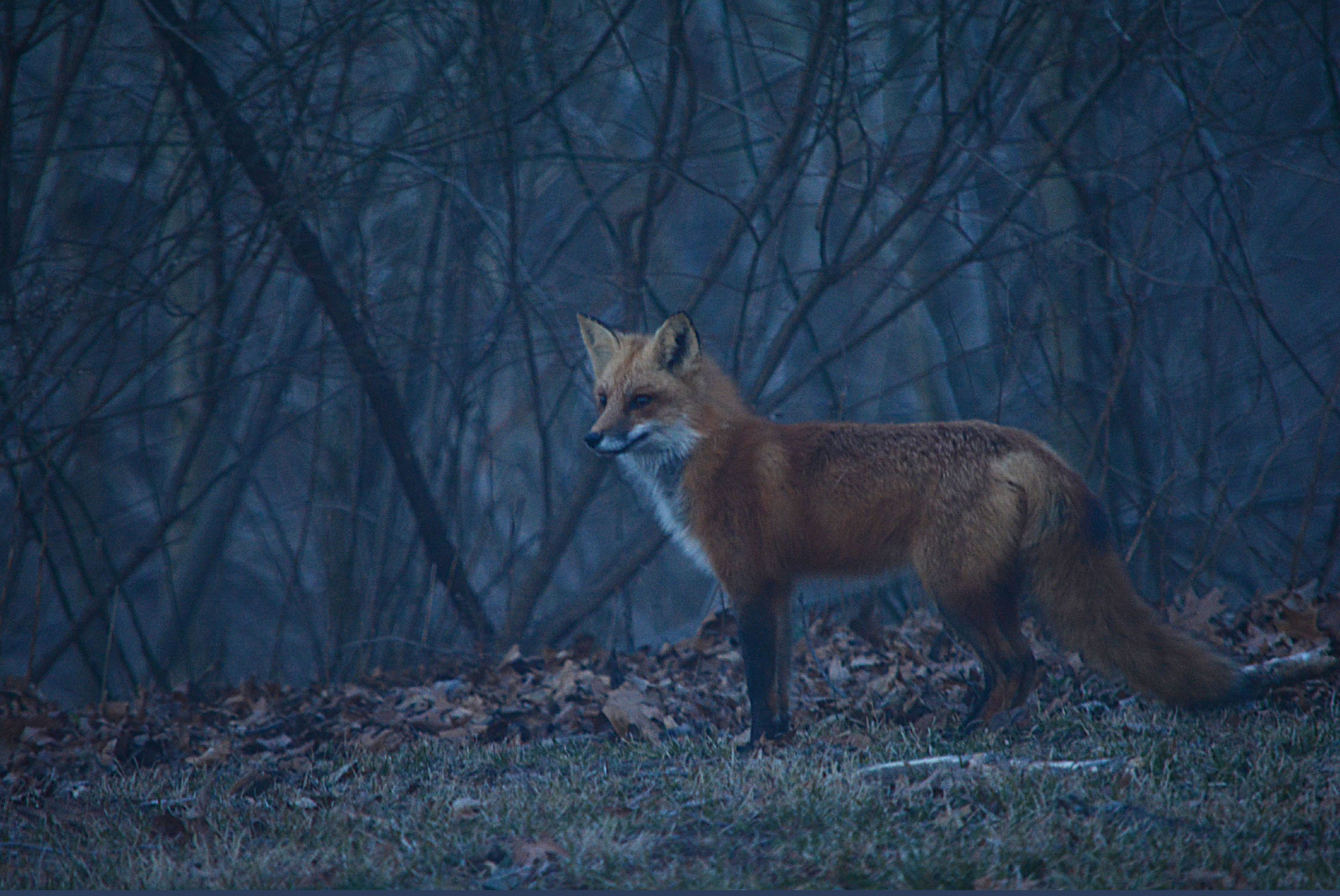|
Golden Shiner
The golden shiner (''Notemigonus crysoleucas'') is a species of freshwater ray-finned fish belonging to the family Leuciscidae. This fish occurs in Eastern North America. It is the sole member of its genus. Commonly used as a bait fish, it is probably the most widely pond-cultured fish in the United States. It can be found in Quebec, and its French name is "Mené jaune" or "Chatte de l'Est". Taxonomy It is the only North American member of the subfamily Leuciscinae, within which it occupies a relatively basal position, though still rather derived. All other members of this subfamily are found in Eurasia. Fossil remains of ''Notemigonus'' sp. have been recovered from the Late Miocene-aged Montbrook fossil site of Florida, US. Description Though it has been known to reach lengths of , in the wild the golden shiner is usually between long. The body is laterally compressed (deep-bodied). The back is dark green or olive, and the belly is a silvery white. The sides are silver ... [...More Info...] [...Related Items...] OR: [Wikipedia] [Google] [Baidu] |
Late Miocene
The Late Miocene (also known as Upper Miocene) is a sub-epoch of the Miocene epoch (geology), Epoch made up of two faunal stage, stages. The Tortonian and Messinian stages comprise the Late Miocene sub-epoch, which lasted from 11.63 Ma (million years ago) to 5.333 Ma. The evolution of ''Homo'' The gibbons (family Hylobatidae) and orangutans (genus ''Pongo'') were the first groups to split from the line leading to the hominins, including humans, then gorillas (genus ''Gorilla''), and finally chimpanzees and bonobos (genus ''Pan (genus), Pan''). The splitting date between hominin and chimpanzee lineages is placed by some between 4 and 8 million years ago, that is, during the Late Miocene. References External links GeoWhen Database - Late Miocene Miocene, .03 Miocene geochronology, 03 Messinian, * Tortonian, * {{geochronology-stub ... [...More Info...] [...Related Items...] OR: [Wikipedia] [Google] [Baidu] |
Common Rudd
The common rudd (''Scardinius erythrophthalmus'') is a benthos, bentho-pelagic freshwater Actinopterygii, ray-finned fish belonging to the Family (biology), family Leuciscidae. This species is widely spread in Europe and central Asia, around the basins of the North Sea, North, Baltic Sea, Baltic, Black Sea, Black, Caspian Sea, Caspian and Aral Sea, Aral seas. Identification Morphologically, this species is very similar to the roach (''Rutilus rutilus''), with which it can be easily confused. It can be identified by the yellow eye colour. The eye of the roach has a big red spot above the pupil, that can be more or less conspicuous. The rudd has an upturned mouth allowing it to feed easily at the top of the water. The placement of the dorsal fin is more to the rear which is even visible in very young fish. There are normally only one or two scales between the tip of the pelvic fins and the anal fins, while on the roach there are five. Also the skin of the rudd is yellowish green, w ... [...More Info...] [...Related Items...] OR: [Wikipedia] [Google] [Baidu] |
Pumpkinseed
The pumpkinseed (''Lepomis gibbosus''), also referred to as sun perch, pond perch, common sunfish, punkie, sunfish, sunny, and kivver, is a small to medium–sized freshwater fish of the genus ''Lepomis'' (true sunfishes), from the sunfish family (biology), family (Centrarchidae) in the order (biology), order Centrarchiformes. It is endemism, endemic to eastern North America. Etymology ''Lepomis'', in Greek, means 'scaled gill cover' and ''wikt:gibbosus, gibbosus'' means 'humped'. The defining characteristic of a pumpkinseed sunfish is the bright red spot at the tip of the ear flap. The pumpkinseed sunfish is widely recognized by its shape of a pumpkin seed, from which its common name comes. See also Wiktionary link below. Description Pumpkinseeds have a body shaped much like a pumpkin seed (thus the common name), typically about but up to in length. They typically weigh less than , with the world record being caught by Robert Warne while fishing Honeoye Lake, Upstate New ... [...More Info...] [...Related Items...] OR: [Wikipedia] [Google] [Baidu] |
Morone
''Morone'' is a genus of temperate basses native to the Atlantic coast of North America and the freshwater systems of the midwestern and eastern United States. Etymology The word ''morone'' is an archaic variation of "maroon". American politician-naturalist Samuel Latham Mitchill (1764-1831) first coined the genus in 1814, describing all four species of "perch of New York" he included under the genus (only two of which still remain classified under the genus today) as having " ruddy", " scarlet", or "reddish, rusty and ochreous" fin A fin is a thin component or appendage attached to a larger body or structure. Fins typically function as foils that produce lift or thrust, or provide the ability to steer or stabilize motion while traveling in water, air, or other fluids. F ...s. Species The currently recognized species in this genus are: References Extant Eocene first appearances {{Acanthuriformes-stub ... [...More Info...] [...Related Items...] OR: [Wikipedia] [Google] [Baidu] |
Micropterus
''Micropterus'' is a genus of North American freshwater fish collectively known as the black bass, which belong to the sunfish family (biology), family Centrarchidae of order (biology), order Centrarchiformes. They are sometimes erroneously called "black trout", but the name trout more correctly refers to certain potamodromous members of the family Salmonidae (order Salmoniformes). ''Micropterus'' are widely distributed east of the Rocky Mountains, from the Hudson Bay basin in Canada to northeastern Mexico. Several species, notably the largemouth bass, largemouth and smallmouth bass, have been very widely introduced species, introduced throughout the world, and are now considered cosmopolitan (species), cosmopolitan. All black bass species are highly sought-after game fish and well known as strong fighters when angling, hooked, and bass fishing is an extremely popular outdoor sport throughout their native range. Their meat is quite edible and firm, although they are not regarde ... [...More Info...] [...Related Items...] OR: [Wikipedia] [Google] [Baidu] |
Bass (fish)
Bass (; : bass) is a common name shared by many species of ray-finned fish from the large clade Percomorpha, mainly belonging to the order (biology), orders Perciformes and Moroniformes, encompassing both freshwater fish, freshwater and marine fish, marine species. The word ''bass'' comes from Middle English , meaning "perch", despite that none of the commonly referred bass species belong to the perch family (biology), family Percidae. Types * The black basses, such as the Choctaw bass (''Micropterus haiaka''), Guadalupe bass (''M. treculii''), largemouth bass (''M. salmoides''), smallmouth bass (''M. dolomieu''), and spotted bass (''M. punctulatus''), belong to the genus ''Micropterus'' of the sunfish family Centrarchidae. * The temperate basses, such as the European seabass (''Dicentrarchus labrax''), striped bass (''Morone saxatilis'') and white bass (''M. chrysops''), belong to the two extant taxon, extant genera ''Dicentrarchus'' and ''Morone'' of the family Moronidae. * Th ... [...More Info...] [...Related Items...] OR: [Wikipedia] [Google] [Baidu] |
Trout
Trout (: trout) is a generic common name for numerous species of carnivorous freshwater ray-finned fishes belonging to the genera '' Oncorhynchus'', ''Salmo'' and ''Salvelinus'', all of which are members of the subfamily Salmoninae in the family Salmonidae. The word ''trout'' is also used for some similar-shaped but non-salmonid fish, such as the spotted seatrout/speckled trout (''Cynoscion nebulosus'', which is actually a croaker). Trout are closely related to salmon and have similar migratory life cycles. Most trout are strictly potamodromous, spending their entire lives exclusively in freshwater lakes, rivers and wetlands and migrating upstream to spawn in the shallow gravel beds of smaller headwater creeks. The hatched fry and juvenile trout, known as ''alevin'' and ''parr'', will stay upstream growing for years before migrating down to larger waterbodies as maturing adults. There are some anadromous species of trout, such as the steelhead (a coastal subs ... [...More Info...] [...Related Items...] OR: [Wikipedia] [Google] [Baidu] |
Phytoplankton
Phytoplankton () are the autotrophic (self-feeding) components of the plankton community and a key part of ocean and freshwater Aquatic ecosystem, ecosystems. The name comes from the Greek language, Greek words (), meaning 'plant', and (), meaning 'wanderer' or 'drifter'. Phytoplankton obtain their energy through photosynthesis, as trees and other plants do on land. This means phytoplankton must have light from the sun, so they live in the well-lit surface layers (euphotic zone) of oceans and lakes. In comparison with terrestrial plants, phytoplankton are distributed over a larger surface area, are exposed to less seasonal variation and have markedly faster turnover rates than trees (days versus decades). As a result, phytoplankton respond rapidly on a global scale to climate variations. Phytoplankton form the base of marine and freshwater food webs and are key players in the global carbon cycle. They account for about half of global photosynthetic activity and at least half o ... [...More Info...] [...Related Items...] OR: [Wikipedia] [Google] [Baidu] |
Zooplankton
Zooplankton are the heterotrophic component of the planktonic community (the " zoo-" prefix comes from ), having to consume other organisms to thrive. Plankton are aquatic organisms that are unable to swim effectively against currents. Consequently, they drift or are carried along by currents in the ocean, or by currents in seas, lakes or rivers. Zooplankton can be contrasted with phytoplankton (cyanobacteria and microalgae), which are the plant-like component of the plankton community (the " phyto-" prefix comes from , although taxonomically ''not'' plants). Zooplankton are heterotrophic (other-feeding), whereas phytoplankton are autotrophic (self-feeding), often generating biological energy and macromolecules through chlorophyllic carbon fixation using sunlightin other words, zooplankton cannot manufacture their own food, while phytoplankton can. As a result, zooplankton must acquire nutrients by feeding on other organisms such as phytoplankton, which are generally smaller t ... [...More Info...] [...Related Items...] OR: [Wikipedia] [Google] [Baidu] |
Animal Diversity Web
The Animal Diversity Web (ADW) is a non-profit group that hosts an online database site that collects natural history, classification, species characteristics, conservation biology, and distribution information on species of animals. The website includes photographs, sound clips, and a virtual museum. The local, relational database is written and maintained by staff and student contributors from the University of Michigan. It can be accessed through the web and mobile apps. It offers resources for schoolteachers ("K–12 instructors"),The Animal Diversity Web Myers, P., R. Espinosa, C. S. Parr, T. Jones, G. S. Hammond, and T. A. Dewey. 2017. and functions as a virtual museum containing mostly mammals and a collection of skulls that can be virtually handled. Background The ADW was created in 1995 by Philip Myers, a forme ...[...More Info...] [...Related Items...] OR: [Wikipedia] [Google] [Baidu] |
Planktivores
A planktivore is an aquatic organism that feeds on planktonic food, including zooplankton and phytoplankton. Planktivorous organisms encompass a range of some of the planet's smallest to largest multicellular animals in both the present day and in the past billion years; basking sharks and copepods are just two examples of giant and microscopic organisms that feed upon plankton. Planktivory can be an important mechanism of top-down control that contributes to trophic cascades in aquatic and marine systems. There is a tremendous diversity of feeding strategies and behaviors that planktivores utilize to capture prey. Some planktivores utilize tides and currents to migrate between estuaries and coastal waters; other aquatic planktivores reside in lakes or reservoirs where diverse assemblages of plankton are present, or migrate vertically in the water column searching for prey. Planktivore populations can impact the abundance and community composition of planktonic species through th ... [...More Info...] [...Related Items...] OR: [Wikipedia] [Google] [Baidu] |
Crepuscular
In zoology, a crepuscular animal is one that is active primarily during the twilight period, being matutinal (active during dawn), vespertine (biology), vespertine/vespertinal (active during dusk), or both. This is distinguished from diurnality, diurnal and nocturnality, nocturnal behavior, where an animal is active during the hours of daytime and of night, respectively. Some crepuscular animals may also be active by moonlight or during an overcast day. Matutinal animals are active only after dawn, and vespertine (biology), vespertine only before dusk. A number of factors affect the time of day an animal is active. Predation, Predators hunt when their prey is available, and prey try to avoid the times when their principal predators are at large. The temperature may be too high at midday or too low at night. Some creatures may adjust their activities depending on local competition. Etymology and usage The word ''crepuscular'' derives from the Latin ''wiktionary:crepusculum, cre ... [...More Info...] [...Related Items...] OR: [Wikipedia] [Google] [Baidu] |

